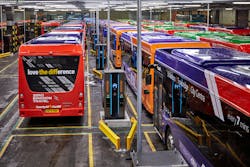Optimizing Transit Fleet Electrification With Advanced Battery Management
Electrifying transit fleets is a pivotal step toward sustainable transportation. However, managing the lifecycle of electric vehicle (EV) batteries is essential for maximizing the return on investment and operational efficiency.
The importance of battery management
Battery management is critical for the success of transit fleet electrification projects. Proper management not only ensures reliable battery performance, but also maximizes battery life and enhances residual value, reducing the total cost of ownership of an electric fleet. Given that batteries represent a substantial portion of the investment in EVs—accounting for 40 to 50 percent of the purchase price—effective battery management is crucial. For example, an electric bus can cost around $400,000 upfront.
Understanding battery degradation
Battery degradation is an inevitable process where the battery’s energy storage capacity diminishes over time. Key concepts include the State of Health (SOH), which measures a battery’s capacity compared to its original state, and the “knee point,” the stage at which battery degradation accelerates rapidly. This typically occurs around 70 percent SOH, signaling the need for replacement. Good battery management practices are essential to delay reaching the knee point, ensuring reliable performance and extending the battery's life.
Benefits of second-life batteries
Batteries still have significant utility after their primary life in EVs. Second-life batteries extend the usable life of EV batteries, offering lower-cost, lower-carbon energy solutions. These applications include portable power sources, on-site renewable energy storage and temporary power solutions for construction or events. What’s more, repurposing retired EV batteries for these purposes contributes to a circular economy, reduces environmental impact and can drive lower first-life costs thanks to the residual value that can be assigned.
Battery-as-a-Service: A game-changer
The Battery-as-a-Service model offers numerous advantages:
- Cost reduction: Lower upfront costs and predictable monthly fees.
- Risk mitigation: The model handles battery performance, degradation, replacement and recycling.
- Operational efficiency: Transit fleet operators can focus on their core missions without worrying about battery management complexities.
Practical tips for transit fleet operators
Transit fleet operators can adopt various strategies to optimize battery performance and lifespan. Route allocation is crucial; varying of routes ensures even battery degradation, considered scheduling can avoid frequent ultra-fast charging. Maintaining batteries within a 10 to 90 percent state of charge can minimize degradation and training drivers to adopt efficient driving styles can further reduce energy consumption and battery wear.
End-to-end electrification
Battery management strategies have been successfully implemented in various projects in the U.S. and abroad. Several transit operators have considered end-to-end solutions that include financing of vehicles and chargers but those with a longer-term mindset are also considering the financing and management of batteries. From the funding of the batteries, to software to manage them and how they ‘re used in second-life applications – the practical benefits of battery management cannot be underestimated.
Conclusion
Transit fleet electrification, supported by advanced transportation technology and effective battery management, is a cornerstone of the advancing sustainable transport movement. By adopting a comprehensive Battery-as-a-Service model and embracing second-life battery applications, transit fleet operators can ensure their EV batteries deliver optimal performance throughout their lifecycle, providing both economic and environmental benefits.
About the Author

Steven Meersman
one of the founder directors of Zenobē
Steven Meersman is one of the founder directors of Zenobē.
Meersman leads the electric vehicle team. In addition, he’s responsible for the Delivery, Operations and Product teams.
Prior to Zenobē, Meersman spent nearly two decades between battery and traded energy commodity markets. He was a global head of deals desk at Trafigura, where he led the commercial optimization and market risk management teams for two refineries and more than 30 import terminals and storage sites across Africa and Central America. Before this role, he was part of Oliver Wyman, where he supported trading houses and utilities on optimizing asset-backed trading strategies, as well as investment and disposals of energy related infrastructure. He started his career in batteries as part of the team that set up AES Energy Storage (now Fluence).


